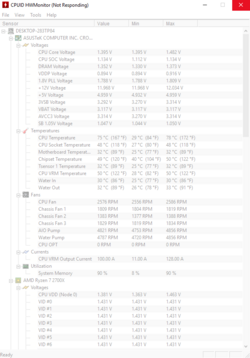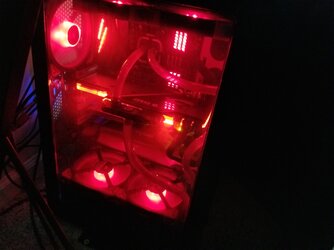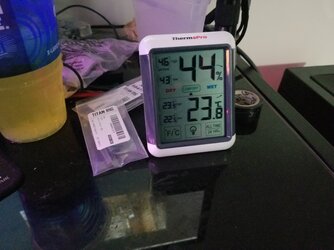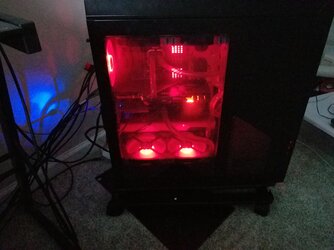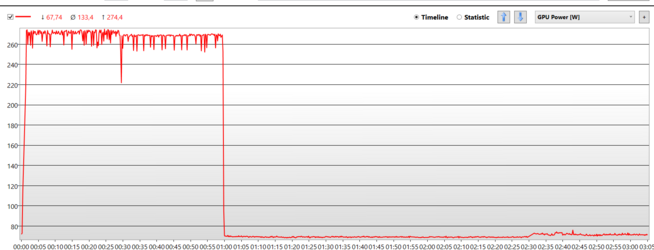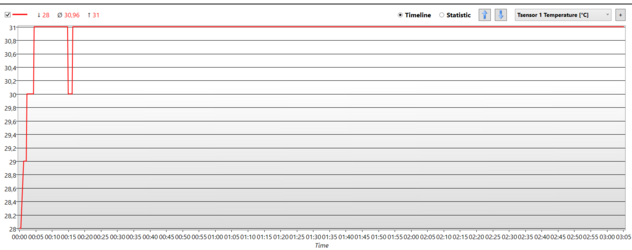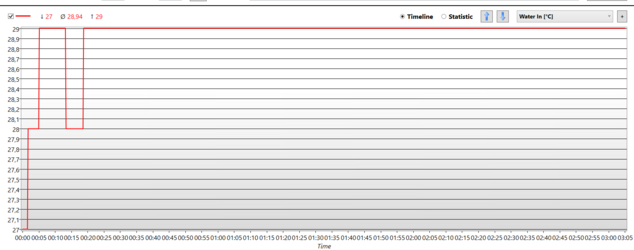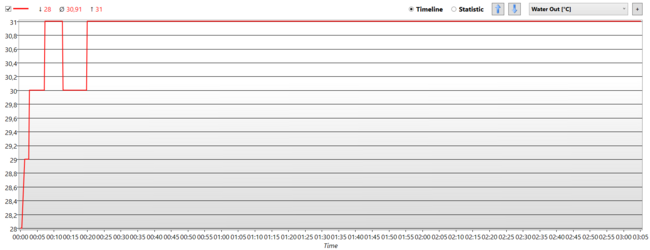- Joined
- Mar 22, 2010
- Location
- Raleigh, NC
Hello all -
I have been running my loop for some time but I looked around for any kind of consensus on case airflow with multiple radiators and top rad intake vs exhaust, with 3 radiator setup (however 2 radiators or any above 1 should also be somewhat similar).
There are a lot of claims and assumptions in various internet tech forums -- about certain things regarding this type of scenario:
+Balanced airflow is best school of thought (top rad exhaust)
+All intake is best
But underlying this is what drove me to test this myself, the other factors people had assumptions about regarding these two options --
+Pushing all warm intake air in case is bad (exhausting internal with all cold air intake for rads)
+Fans would be working against each other and not be as efficient (too much positive pressure)
+Various claims that, total air, heat exchange saturation would not be 100 percent, so that the exhausting rad would still benefit from air although some of the warm air would be being used to try and cool a top external exhausting rad
My testing setup:
-------------------
Single Loop
Ryzen 2700x OC PBO 1.5volts max 4.3ghz max, 4.2ghz all core boost
2080ti seahawk x - OC to 2140-60 mhz 110% power limit + 400 memory
Asus Crosshair 6 forumla
Phanteks Enthoo primo
alphacool ut 60 420 top rad
alphacool ut 60 280 bottom rad
hwlabs gts 240 rad front
dual d5 pumps (xspc bay rez)
EK waterblock for 2080ti seahawk
XSPC raystorm pro cpu block
Fans -- corsair ML 140 pro LED on one side, rosewill hyperborea 140 on opposite side for push pull rads (bottom and top) corsair ML 120 pro LED on front rad push only
Testing methodology (may be changed)
-------------------------------------------
Temp sensors placed at bottom and front rad air outflow into case (exhausting hot air into case for all intake radiator test)
Temp of water measured with sensor in rad drain port
(flow meter has not been installed yet)
Ambient temp sensor on desk with humidity measurement also
CPU socket
CPU temp
Motherboard temp
Chipset temp
CPU VRM temp
All intakes have dust filters left on, and case is closed - may test with side panel off as well.
Stress test will be 30 min of AIDA 64 CPU/RAM/GPU stress test
I have been running my loop for some time but I looked around for any kind of consensus on case airflow with multiple radiators and top rad intake vs exhaust, with 3 radiator setup (however 2 radiators or any above 1 should also be somewhat similar).
There are a lot of claims and assumptions in various internet tech forums -- about certain things regarding this type of scenario:
+Balanced airflow is best school of thought (top rad exhaust)
+All intake is best
But underlying this is what drove me to test this myself, the other factors people had assumptions about regarding these two options --
+Pushing all warm intake air in case is bad (exhausting internal with all cold air intake for rads)
+Fans would be working against each other and not be as efficient (too much positive pressure)
+Various claims that, total air, heat exchange saturation would not be 100 percent, so that the exhausting rad would still benefit from air although some of the warm air would be being used to try and cool a top external exhausting rad
My testing setup:
-------------------
Single Loop
Ryzen 2700x OC PBO 1.5volts max 4.3ghz max, 4.2ghz all core boost
2080ti seahawk x - OC to 2140-60 mhz 110% power limit + 400 memory
Asus Crosshair 6 forumla
Phanteks Enthoo primo
alphacool ut 60 420 top rad
alphacool ut 60 280 bottom rad
hwlabs gts 240 rad front
dual d5 pumps (xspc bay rez)
EK waterblock for 2080ti seahawk
XSPC raystorm pro cpu block
Fans -- corsair ML 140 pro LED on one side, rosewill hyperborea 140 on opposite side for push pull rads (bottom and top) corsair ML 120 pro LED on front rad push only
Testing methodology (may be changed)
-------------------------------------------
Temp sensors placed at bottom and front rad air outflow into case (exhausting hot air into case for all intake radiator test)
Temp of water measured with sensor in rad drain port
(flow meter has not been installed yet)
Ambient temp sensor on desk with humidity measurement also
CPU socket
CPU temp
Motherboard temp
Chipset temp
CPU VRM temp
All intakes have dust filters left on, and case is closed - may test with side panel off as well.
Stress test will be 30 min of AIDA 64 CPU/RAM/GPU stress test
Last edited:
